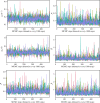Reconciling early-outbreak estimates of the basic reproductive number and its uncertainty: framework and applications to the novel coronavirus (SARS-CoV-2) outbreak
- PMID: 32693748
- PMCID: PMC7423425
- DOI: 10.1098/rsif.2020.0144
Reconciling early-outbreak estimates of the basic reproductive number and its uncertainty: framework and applications to the novel coronavirus (SARS-CoV-2) outbreak
Abstract
A novel coronavirus (SARS-CoV-2) emerged as a global threat in December 2019. As the epidemic progresses, disease modellers continue to focus on estimating the basic reproductive number [Formula: see text]-the average number of secondary cases caused by a primary case in an otherwise susceptible population. The modelling approaches and resulting estimates of [Formula: see text] during the beginning of the outbreak vary widely, despite relying on similar data sources. Here, we present a statistical framework for comparing and combining different estimates of [Formula: see text] across a wide range of models by decomposing the basic reproductive number into three key quantities: the exponential growth rate, the mean generation interval and the generation-interval dispersion. We apply our framework to early estimates of [Formula: see text] for the SARS-CoV-2 outbreak, showing that many [Formula: see text] estimates are overly confident. Our results emphasize the importance of propagating uncertainties in all components of [Formula: see text], including the shape of the generation-interval distribution, in efforts to estimate [Formula: see text] at the outset of an epidemic.
Keywords: Bayesian multilevel model; COVID-19; SARS-CoV-2; basic reproductive number; generation interval; novel coronavirus.
Conflict of interest statement
We declare no competing interests.
Figures





References
-
- World Health Organization 2020. Pneumonia of unknown cause—China. www.who.int/csr/don/05-january-2020-pneumonia-of-unkown-cause-china/en/ (accessed 30 January 2020).
-
- He X. et al. 2020. Temporal dynamics in viral shedding and transmissibility of COVID-19. Nat. Med. 26, 672–675. - PubMed
-
- World Health Organization 2020. Coronavirus disease 2019 (COVID-19) situation report – 112. www.who.int/docs/default-source/coronaviruse/situation-reports/20200511-... (accessed 11 May 2020).
-
- Bedford T, Neher R, Hadfield J, Hodcroft E, Ilcisin M, Müller N. 2020. Genomic analysis of nCoV spread. Situation report 2020-01-23. https://nextstrain.org/narratives/ncov/sit-rep/2020-01-23 (accessed 24 January 2020).
Publication types
MeSH terms
Grants and funding
LinkOut - more resources
Full Text Sources
Research Materials
Miscellaneous
